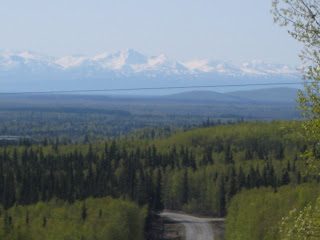
The best ice cream in the world and a Fairbanks tradition -- my guilty summer pleasure! Favorite flavors are Ginger, Green Tea, and Torrone. Speaking of Summer, we have had maybe 5 days of weather in the 70's, but for the most part it is still pretty cold -- in the 30's at night. Sunrise this morning was 3:37 am and sunset will be at 12:02 am (May 31). It is really light all the time!
Most of the scenery has gone from white to green. However, lest you think the title of this blog is no longer appropriate, notice that the Alaska Range is still covered in snow.
 I know I have said it before "... this is as clear as the Alaska Range will get". Well this is probably as clear as it will get from the top of Ballaine Hill.
I know I have said it before "... this is as clear as the Alaska Range will get". Well this is probably as clear as it will get from the top of Ballaine Hill. The only reminders of winter here are the red snow shovel and skis leaning against the cabin.
The only reminders of winter here are the red snow shovel and skis leaning against the cabin.
Compare ... the cabin in winter
From the Chapter "In Fairbanks, sophistication means your wool socks match" I quote one of the rules for newcomers: Don't say anything bad about Fairbanks. The people who live there know they're not very smart. Why else would they stay in a place where it is winter nine months of the year? Where it gets so cold your car's tires freeze and so does any part of your body that's not covered? By several layers? Where the most exciting thing to do is wait for a new weather forecast. Fairbanksans know all this. And they're afraid that if anybody says it out loud, their neighbors will say, "You know, that's right? I'm leaving." And property values will drop faster than the temperature in January. (Fashion Means Your Fur Hat is Dead: A Guide to Good Manners and Social Survival in Alaska by Mike Doogan) Believe it or not, I have heard real-life conversations like this many times last winter.

An updated view from my main window

Duke asleep on the front porch

... and on Willow Run

Chicken on the porch
Duke and Chicken are my god-dogs. Ann is away for the summer and I am back-up to the UAF student living in her cabin who is the primary care-giver for the dogs.

Chokecherry trees are all over Fairbanks proper but not seen out of town

... they are lovely
 This is a frog-pond on Willow Run. I have seen two beautiful red foxes around here -- they are as big as small dogs.
This is a frog-pond on Willow Run. I have seen two beautiful red foxes around here -- they are as big as small dogs.
Robins are now frequent visitors to the yard, along with Dark-eyed Juncos, a variety of woodpeckers, and of course the Common Red Polls, Chickadees and Camp Robbers (Gray Jays)
The cabin is filling up with backpacking gear (remember, it is quite small). Closer to the trip I will provide details about the upcoming adventure. Right now I am breaking in my new boots, practicing setting up the tent, and learning how to efficiently load the backpack.































